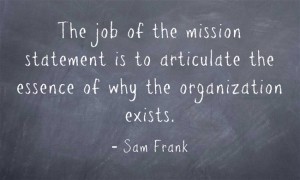Nonprofit mission statements as marketing: a mistake?
Are mission statements being abused by nonprofits? Given all of the heavy lifting we expect of mission statements, is it a mistake to also expect them to serve as effective marketing messages – taglines in particular? We invited mission statement expert, Sam Frank, Principal at Synthesis Partnership, to weigh in on the matter and ended up getting more of a debate than we expected.
First, Sam shared some of his expertise on mission statements; an excellent primer and case for the importance and value of articulating mission statements. However, we invited Sam to guest post because we wanted him to help me convince readers not to use mission statements as marketing messages. It turns out that we don’t entirely agree, and we decided to also share the rest of our conversation with you.
Mission Statement Primer – by Sam Frank
Often when the question of the mission statement comes up with a nonprofit board there are groans.
- We don’t want to get bogged down in wordsmithing; we have more important issues to deal with.
- We all know why we’re here, let’s figure out how to do our work better.
- We worked on that two years ago and gave up because it was a pointless waste of time. Why should we get into that again?
So what is the point of a mission statement? Is it just something you’re supposed to have somewhere for appearance sake and move on to more important things? Or is it worth time and effort to re-examine and craft it to serve a clear purpose?
Here’s my claim: a mission statement is a fundamental tool of strategy, focus, marketing, and identity. It provides the shortest route to your goal… for the simple reason that without it you don’t really know (collectively) what your goal is.
Your mission is the reason you exist. If your organization is to be as effective as possible, its reason/mission needs to be shared by those who govern, manage, work within, volunteer for, and otherwise have a stake in your organization. Unless you express the mission clearly there is no way that everyone involved will have the same understanding of it and be able to work most effectively toward it. Thus the mission statement. The job of the mission statement is to articulate the essence of why the organization exists. If you don’t articulate it, then it’s very likely that there isn’t an essence at all, just a cloud of assumedly similar individual understandings.
So when people advocate working on the mission statement, what they mean is: let’s sharpen what we say about our purpose so that we can work more effectively together to achieve it, and draw more people into our fold to support it.
Once you have the statement it will remind you what is most important and distinctive about your organization. It will help all stakeholders to be clear about the organization they’re involved in, and stay focused. It will help them avoid disappointment that the organization is not doing things they value individually, but are outside the purview of this organization.
The debate
Marlene: Sam, in planning this post, you shared with me your thoughts on what mission statements can offer to internal and external audiences. Can you please share those thoughts with my readers as well?
Sam: Internally, a mission statement is generative tool for clarity and focus. First, through the much-maligned process of wordsmithing, the discussion itself will raise important questions of intention and priority. If the discussion is difficult, that may mean you need to resolve some differences of direction. If well orchestrated, the discussion will be neither interminable nor tedious, but contained, validating and invigorating.
Externally, a mission statement is branding and positioning. It differentiates your organization from others that may do similar work. It captures most compellingly your case for support. It creates awareness for your cause, and it focuses that awareness on you. It unifies your communications so that when people hear about the organization from any source, the message is the same and reinforces what they heard before.
Marlene: This is where I disagree. The process that goes into developing a mission statement is related to, but not one and the same as branding and positioning. And the process of articulating a mission statement is altogether different from the process and skills that are applied to writing effective marketing content.
Given all of the work and value we expect our mission statements to deliver, from articulating strategy and goals, giving organizations focus, defining mandates – everything you described yesterday – I feel it’s too much to also expect them to serve as powerful marketing messages.
Sam: My feeling is that as a distillation of strategy and identity, a mission statement must be both internal and external in its focus. If it captures the essence of the organization’s purpose for internal stakeholders, it should do the same for prospective stakeholders. There is more to a mission statement than marketing, and there is more to marketing than a mission statement, but to me there is a fundamental connection between them.
There are a number of other tools related to mission statements:
A mission statement articulates of the essence of why you exist. It can encompass what you are, but should avoid getting into what you do and how. You can put those things into an associated statement of values or principles.
A vision statement is an aspirational view of the future, capturing either the organizational ideal (arts, culture, education), or a world in which the organization is no longer needed (poverty, specific diseases).
An elevator pitch is an expansion of the mission statement, giving a concrete, vivid, memorable, compelling overview of the organization in the one or two minutes you have someone’s attention.
A tagline grabs attention, but may or may not fully convey the mission. If it does, it may also serve as the mission statement. I don’t think that a mission statement always works as a tagline but I think it’s one option. It seems a waste not to use a mission statement in promoting an organization.
Marlene: This is where I particularly disagree; I think mission statements and taglines are necessarily two very distinct properties. In my view, mission statements are often too long, language is too formal, focus too internal and they don’t have the personality or tone that you’d want from a tagline. I feel it’s a mistake to use a mission statement as a tagline, or given what I’ve just described, to even use one on marketing materials at all.
Taglines are meant to communicate the essence and personality of an organization, not articulate its entire mandate. They need to be accessible and memorable. Taglines are often positioned with or integrated into logos and repeated across a wide range of an organization’s marketing materials; all of this leading to the need for taglines to be concise. I have rarely seen a mission statement that meets all of these criteria sufficiently to appropriately do double-duty as a tagline.
Sam: Thanks for inviting me to this conversation; I’ve enjoyed the exchange of views. Our disagreement on the role of a mission statement brings some important issues to light. I don’t know that we need to—or even could—fully reconcile our positions, but I propose another post in which we each comment on some examples. I’d be delighted to have you challenge my assumptions.
Links
For more on mission statements see:
Readers: What do you think? Has your organization been successfully using a mission statement as a tagline? Is there merit to this practice? Do you have any examples of great taglines that also serve as mission statements, or vice versa? Or do you feel mission statements should not be used as taglines because you’ve seen examples of this done poorly?
Would you like to see a Part 3 of this topic? Please share your examples with us!
Thank you again to Sam for sharing his expertise and views!
About Sam
Sam Frank, Principal, Synthesis Partnership, advising nonprofits in strategy, planning and organizational development, and Director, , offering free professional development for nonprofit trustees and staff.



 PRINT
PRINT
